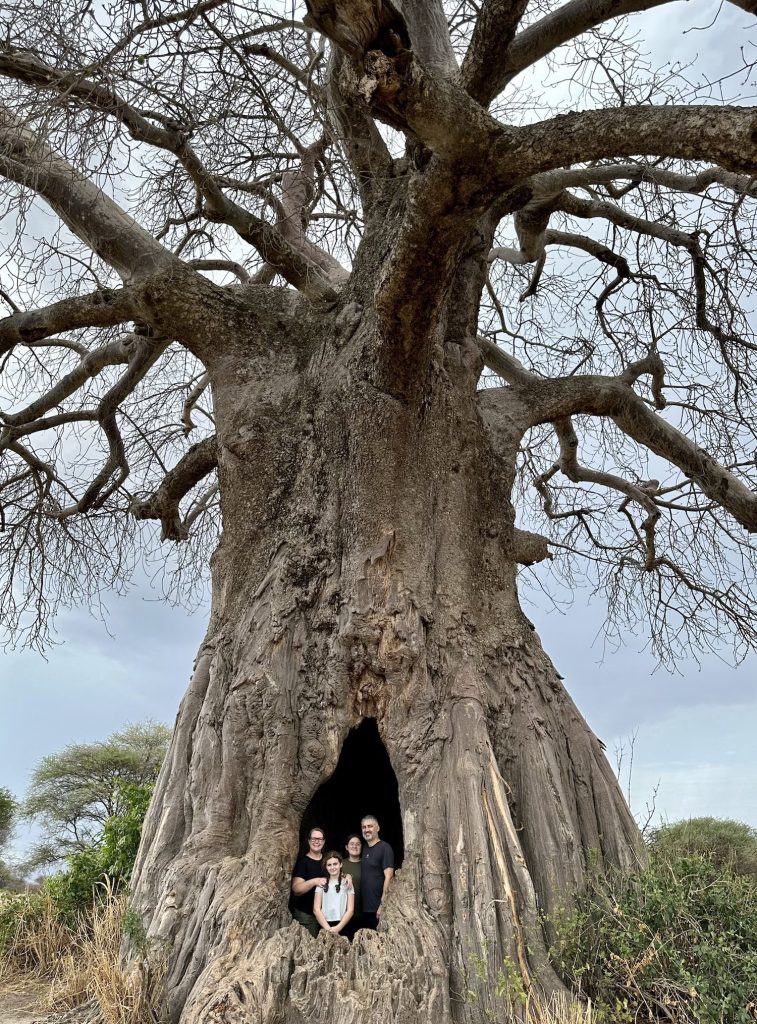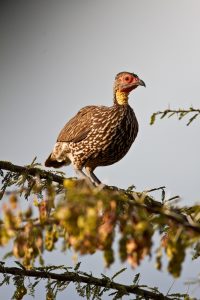Tarangire National Park is located in the northern part of Tanzania and a popular spot for tourists who are traveling to the Northern circuit. It is strategically located between the Great Rift Valley and the Masai steppe in the southern part of Lake Manyara National Park. Tarangire covers an area of 2600 square kilometers with a wide range of wildlife and amazing safari activities that will keep you on your toes throughout your stay. It was named after the Tarangire River which crosses the National Park and acts as a primary source of water for the animals.
Tarangire has a pleasant climate which can be described as wet and dry seasons. March to May receive the long rains and November to December have the short rains. Note that it does not rain the whole day but you need to be ready for the showers, especially in the mornings and evenings. Pack a few warm clothes for such occasions. June to October are usually dry months with a temperature between 26 degrees Celsius during the day and 14 degrees Celsius at night.
The best time for visiting Tarangire National Park
The dry season (June to September) is the recommended time for tourists visiting Tarangire National Park because most of the safari activities are best carried out during the dry season although it is also known to be a good destination all year round even during the green season. Wildlife especially animal species are best seen during the dry season when the grass has thinned out and the vegetation is short. The green/wet/low season (November to April) is when the grass is longer which makes it hard to see the animals. It is however the best time to go bird watching since the migratory birds fly in during the wet season.
How to get to Tarangire National Park
The National Park can easily be accessed through different means which include road and air transport.
By air: air transport is the fastest and most comfortable type of transport that tourists can use to get to the Tarangire National Park. There are several airstrips that can be used and these include Kuro airstrip and Tarangire airstrip. Charter flights can easily be arranged and there are scheduled flights that are available for tourists.
By road: Tarangire is approximately 2 to 3 hours from Arusha covering 140 kilometers. The drive starts from Arusha and is considered to be the most scenic and cheap way of getting to Tarangire National Park.
Rules and regulations in Tarangire National Park
Before gaining entrance to Tarangire National Park, all tourists are briefed about the rules and regulations that were set up to protect wildlife. These rules apply to the different safari activities that are carried out in the National Park and these include the following:
- Do not litter the Park: all rubbish is supposed to be disposed of in the bins in your safari vehicles and taken back to where you are staying. These rules help in the conservation of the National Park and at the same time reduce risks related to litter especially the polythene bags that might cause harm to the animals.
- Avoid feeding wild animals because it is not allowed. Constant feeding of the wildlife will make it hard for them to survive on their own when no one is around to feed them so you should avoid it as much as possible.
- Tourists cannot access the National Park without a licensed guide. Local licensed guides are experienced and know their way around the National Park including the best spots for wildlife viewing.
- Do not make noise or minimize talking while near wildlife. Noise usually scares the animals and birds away and that is why you should not make noise, turn off your phones or keep in flight mode and turn off the radios.
- Tourists who are interested in camping should turn to extinguish the fire at night to avoid it from spreading and causing damage to wildlife. The fire also attracts wildlife and you do not wish to walk outside and find a lion next to your tent.
- Tourists are also not allowed to move out of their tents alone at night. In case of an emergency, ask someone to move out with you if possible the tour guide.
Tourist attractions in Tarangire National Park
Tarangire River
Tarangire River is the main attraction in the National Park because it serves as the main water source for the wildlife in the Park. Animals that converge around the River include buffaloes, leopards, spotted hyenas, wildebeests, zebras, lions, elephants, gazelles, and different types of antelopes among others.
The Tarangire elephants
Tarangire is believed to hold the largest elephant population in Tanzania making them a top tourist attraction in the National Park. The large African elephants are best seen during the dry season as they search for water at the now almost dry Tarangire River and other waterholes. You can see over 300 elephants milling around and the beauty of Tarangire is that you can still see the elephants during the wet season due to the large crowds.
The silale swamp
Silale Swamp is one of the main attractions in Tarangire that make up the ecosystem of the National Park. The swamp is a practical sponge during the dry wet season and during the season, it releases all the soaked-up water attracting large crowds of animals like the African wild dog, elephants, lions, silale swamp lions, cape buffalos, and numerous bird species.
Poacher’s hide
The poacher’s side is located in the southwestern part of Tarangire and is a famous place for every tourist to see. It is an old baobab tree that has a hidden chamber and door where poachers used to hide. Poacher’s hide is believed to be over 300 years old with a diameter of 10 meters.
Lemiyon Triangle
Lemiyon Triangle is nestled in the northern part of Tarangire and is one of the best places to visit within the National Park for birders due to the presence of raptors. The triangle is filled with large baobab trees where many raptors can be seen and even if you are not an ardent birder, this one place will keep you entertained.
The giant baobab tree
this is an extremely large trunk also known as the Tree of Life. Baobabs are believed to have a life expectancy of about 600 years producing fruit for wild animals, especially elephants. The giant baobab collects and retains water in its trunk which has enabled it to keep producing the fruits that are food for the elephants. It was named the tree of life because even during the dry season, it always has fruits which is not the case with the surrounding vegetation.
Activities carried out in Tarangire National Park
Tourists can engage in different safari activities after paying entrance fees and these include the following:
Guided nature walks
Guided nature walks in Tarangire National Park can only be carried out in the presence of a trained and professional tour guide and it involves exploring the National Park on foot in clearly marked areas. The activity helps you get close to the wildlife and surroundings. An armed ranger will also be around to ensure that no harm can come to you as you take your guided nature walk around the National Park. There are a few rules that need to be followed while taking nature walks in Tarangire and these are not getting close to the animals, keeping in a single line with the guide or armed ranger leading the way and you need to either talking in whispers or move silently to avoid disrupting the animals.
Game drives in Tarangire
A safari is incomplete without a game drive and it is practically the main activity that most tourists engage in on a safari in Tarangire. Game drives are carried out in three phases which are morning, evening, and night drives although instead of going for the morning or evening drives, you can as well enjoy a full game drive where you get to spend the whole day driving through the National Park while enjoying game drives (you will need to carry lots of snacks, lunch and bottled water since you won’t be returning to the lodge till evening).
Morning game drives start very early in the morning to catch the early bird wildlife that is active in the morning hours and this is considered to be the best time since the animals can easily be spotted. The evening drives are to search for the hard-to-see wildlife and those heading back to their natural habitats after a long day of hunting. Night drives on the other can only be carried out after a special request and normally starts around 7:00 pm taking about 2 to 3 hours. A special spotlight will have to be used so that you can spot the nocturnal animals easily like the African civet, leopards, Caracals, hyenas, and leopards among others.

The best time to go for game drives in Tarangire is during the dry season which is experienced from June to October because this is when the animals can easily be spotted due to the thinning of the vegetation and animals crowding around the waterholes to cool off from the heat. Some of the animals that can be seen during the game drives include zebras, wildebeests, waterbucks, giraffes, elephants, elands, leopards, hyenas, crocodiles, hippos, lions and antelopes among others.
Birding in Tarangire National Park
Best carried out during the wet season experienced from November to March when the migratory birds fly into the National Park, bird watching can be carried out in the different parts of the National Park and some of the equipment that you might need for birding include binoculars, cameras, a recognition book, and a waterproof jacket in case it starts raining. Bird species that are in Tarangire include pink-breasted lark, Donaldson smith’s nightjar, Ashy starling, yellow-collared lovebird, Ostriches, northern white-crowned shrike, Great white pelican, African grey flycatcher, von der Decken’s hornbill, Mouse-colored penduline, Kori bustard, Rufous-tailed weaver, bee-eaters, bare-faced go-away bird, and the Northern pied babbler among others.
Cultural tours around Tarangire area
This is the best way of learning about the locals’ way of life in the surrounding communities. An interaction with the locals that is the Masai will give you a more detailed insight into their nomadic life, their beautiful homesteads called Manyattas, their traditional food, dress code, and their jumping dance. While there, you will be able to participate in the different activities, and do not forget to buy yourself a few souvenirs like beads, colored clothes, and other crafts because the money got supplements their meager income.
Entrance fees to Tarangire National Park
Residents: Children 7.5USD
Adults 25 USD (peak season), 22.5USD (low season)
Non-residents: Children 15 USD
Adults 50USD (peak season), 45USD (low season).
EAC citizens : Children 2, 000 Tanzania shillings
Adults 10, 000 Tanzania shillings
Children are persons that are between 5 to 15 years old
Adults are 16 years and above.
Note that the entrance fees are valid for only 24 hours and they are subject to change.
Accommodation in Tarangire National Park
There are several safari camps and lodges that are within the National Park whereas others are found in the neighboring villages. Accommodation options in and around Tarangire range from budget, mid-range, and luxury facilities so no matter your safari budget, you can always get good and comfortable accommodation. Some of the accommodation facilities found inside the National Park that we recommend include
Luxury accommodation facilities
Swala safari camp
Tarangire Treetops
Nimali Tarangire
Mid-range accommodation facilities
Tarangire safari lodge
Sangaiwe Tented lodge
Tarangire Sopa lodge
Maramboi Tented camp
